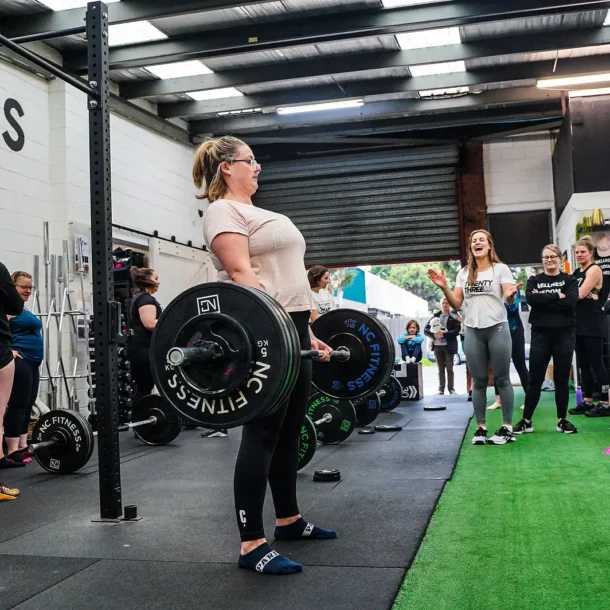

We love working with expectant mums! It is truly a beautiful time in a women’s life of rapid change and learning and adapting.
In previous blogs we have unpacked exercise consideration while pregnant, such as ‘Safe Exercise Guidelines for Expectant Mothers’ and ‘So You Are Pregnant- How To Navigate Exercise Safely. This blog however, we hope to dive a little deeper into more practical advice on some modifications we love to give our clients during group training.
Do we need to modify?
We would argue that, unlike many forms of exercise, strength training can be a terrific form of exercise to continue up until your due date. There are hundreds of strength training exercises that are not only appropriate during pregnancy, but incredibly beneficial to support a healthy pregnancy and faster recovery.
While there are some common guidelines on what to avoid, every pregnant woman is unique. Her ability and capacity to continue to exercise is dependent on the presence of certain pregnancy related contraindications, training history and fitness level. Having been pregnant myself and worked with many pregnant clients, modification should be implemented when symptoms are experienced. Different exercises might feel different to different women. A good trainer will always be asking her clients ‘how does this feel for you?’ It is important to coach every woman individually.
What are some indicators that modifications are required?
There are some blanket rules we like to apply in the gym when modifying a workout. This could include:
Great substitutions
Barbell Hip Extension
This is a great exercise to target the glutes, but with the bar running along the lower portion of the belly it is a good one to modify early on. Even unweighted glute bridges have the potential to cause dizziness and pelvic girdle pain. This exercise can be modified by elevating your head on to a bench or Bosu, removing the load or opting for a hip thrust march or single leg hip extension instead.
Plank
Frontal planks are fabulous but as the belly increases in size, bulging along in the linea alba is very common. A great modification could be to regress the exercise to the knee, incline up a wall or on a bench, reducing hold duration or moving into a four-point position or changing the exercise to a modified renegade row or bird dog instead.
Deadlifts
There are lots of ways to incorporate hinging movements into a pregnant ladies program. This exercise can be regressed by moving from a conventional deadlift (straight bar) to a trap bar or kettlebells, were the weight is held to the side of the body rather than out in front. The range of movement can also be decreased by elevating the weights off the ground.
Bent-over Row
Similar to deadlifts, the lower back can become overworked in this forward leaning position. Thankfully there are so many ways to target the back muscles. We love standing cable rows, single arm dumbbell rows, face pulls and incline ring row to name a few.
Push Ups
The time to modify this exercise is very much dependent on your clients starting strength. Some common issues might be wrist pain, bulging of the linea alba or form issues. This exercise can easily be changed for push ups on knees or on an incline. Alternatively, we also love standing cable chest flies and presses.
Lunges or Squats
Continuing to squat throughout pregnancy is incredibly beneficial for anyone looking to give birth naturally to develop endurance and mobility in the legs. Symptoms are usually experienced in this exercise with increased depth or load, so changing these variables can be a great regression. As lunges also put all the load through one leg, this can also inflame the pubic area. Symptoms might include heaviness in the perineum or pelvic floor, leaking of urine or the urge to go to the bathroom mid set, or pelvic girdle pain. While I was able to continue to back squat up to my due date, you could change the exercise to suitcase squats, goblet squats, box squats or air squats (no weight at all) or bring the legs closer together.
What about core exercise?
As a general rule, abdominal exercises need to be regressed significantly as the pregnancy progresses. In the first trimester, potentially few modifications will need to be made. Exercises like Russian twists, leg lifts, pikes and sit ups should be substituted for exercises like side planks, Pallof presses, wood chops, bird-dogs, suitcase carries and other anti-rotation exercises. This is especially the case as the belly starts to grow… you need to allow the rectus abdominals to stretch.
What about cardio exercises?
Don’t just think about cardio exercise as running! Any exercise that increases our heart rate is beneficial, so kettlebell sings, rope slams, sled runs, swimming all hit the spot. We highly recommend avoiding any cardio exercises that could increase the chance of injury or cause pelvic floor dysfunction. In the second trimester we do recommend a pregnant woman looks to remove or reduce running distance and pace. Similarly skipping, box jumps and burpees should be substituted for something more appropriate. I particularly enjoyed sleds and Ecco bike in the later phase of my pregnancy.
More Information?
Would you like more information on getting started with us? We specialise in postnatal exercise too. Simply email us at hello@23w.com.au

Ange Drake is an personal trainer, women’s empowerment coach and fitness blogger in the northern suburbs of Melbourne. She is the director of one of the few womens’ only strength training gyms in Melbourne, 23W. Ange helps women to learn how to use strength based training, nutritional strategies and a positive mindset to transform their bodies, relationship with food and mind.
Can’t decide which of our packages is best suited for you? Take our questionnaire to help you decide!





